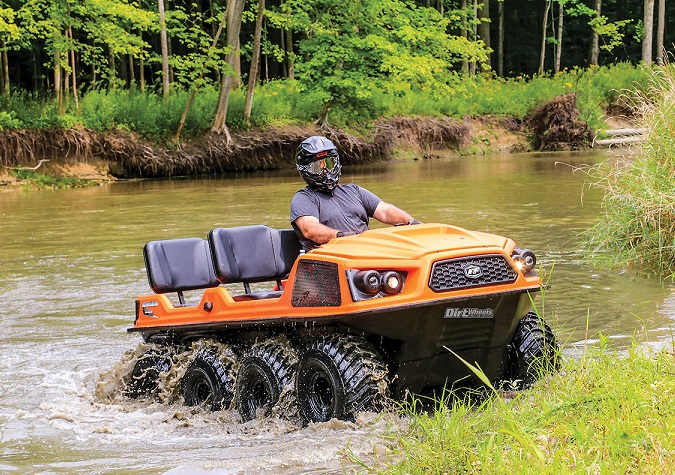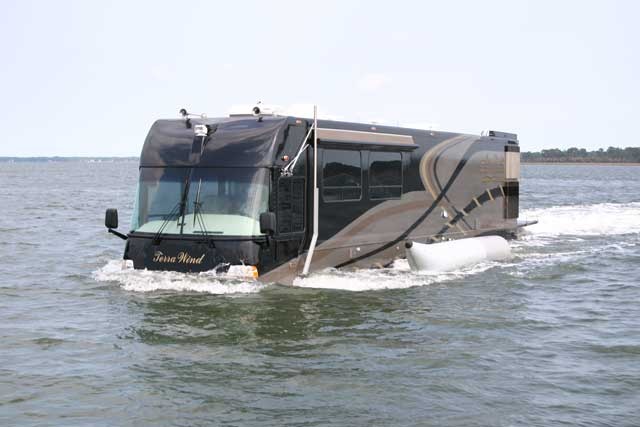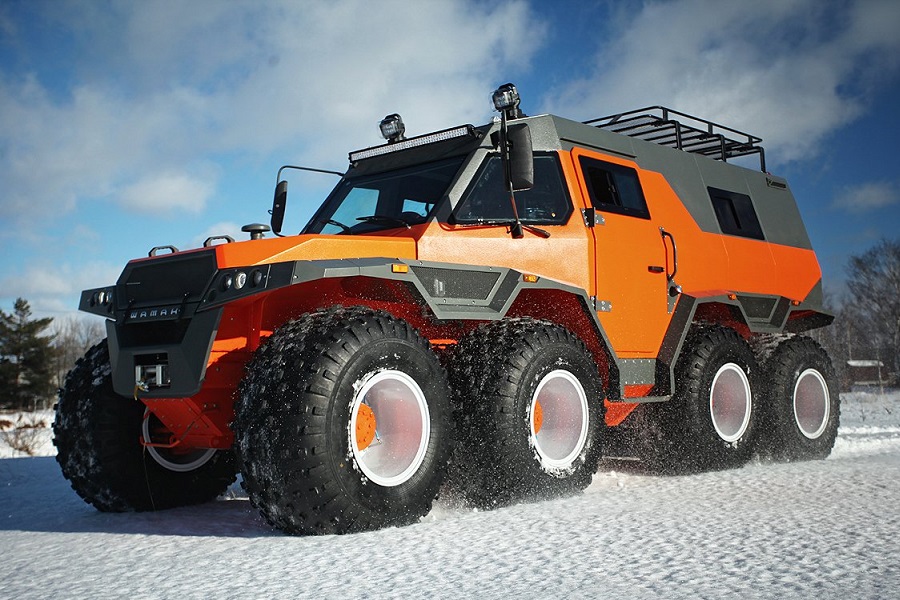
Amphibian Manufacturers Service Manual Directory
Arctic Cat | Gibbs | Sea Lion | Air Lift | Hov Pod | WaterCar
Amphibian Vehicle Definition and Description
An amphibious vehicle (or simply amphibian), is a vehicle that provides a means of transport on land, as well as on (or under) water. Amphibious vehicles include amphibious bicycles, ATVs, cars, buses, trucks, military vehicles, boats and hovercraft.
Types of Amphibious Vehicles
Two main categories of amphibious vehicles are immediately apparent: those that travel on an air-cushion (Hovercraft) and those that do not.
 The
Amphibious Air Cushion Vehicles (ACV) come in all shapes and sizes and
use blowers to produce a large volume of air below the hull, or air
cushion bellows. The higher air pressure below the hull produces lift,
which causes the hull to float above the running surface.
The
Amphibious Air Cushion Vehicles (ACV) come in all shapes and sizes and
use blowers to produce a large volume of air below the hull, or air
cushion bellows. The higher air pressure below the hull produces lift,
which causes the hull to float above the running surface.
These Air Cushion Vehicles can be quite enormous and are often designed to be used as commercial operation vehicles which can include ferry transport vehicles, and military operation vehicles. Many smaller personal ACV vehicle designs have been introduced over the years as well. For stability reasons, the air is typically blown through slots or holes around the outside of a disk or oval-shaped platform, giving most hovercraft a characteristic rounded-rectangle shape.
 With
Amphibious (AMPH) wheeled or tracked vehicles, many designs were prompted
by the desire to expand the off-road capabilities of land-vehicles to
an "all-terrain" ability, including land, water, ice, snow, mud, marsh,
swamp etc.
With
Amphibious (AMPH) wheeled or tracked vehicles, many designs were prompted
by the desire to expand the off-road capabilities of land-vehicles to
an "all-terrain" ability, including land, water, ice, snow, mud, marsh,
swamp etc.
Many designs use tracks in addition to or instead of wheels, while in other designs include articulated body configurations and other unconventional configurations such as screw-propelled vehicles which use auger-like barrels to propel a vehicle through muddy terrain with a twisting motion.
Amphibious Vehicle Characteristics
Most land vehicles – even lightly armored ones – can be made amphibious simply by providing them with a waterproof hull and perhaps a propeller.
For propulsion in or on the water some vehicles simply make do by spinning their wheels or tracks, while others can power their way forward more effectively using a propeller or water jet. Most amphibian vehicles work only as a displacement hull when in the water – while a small number of designs have the capability to raise out of the water when speed is gained to hydroplane with less resistance.
Amphibian Vehicle History of Evolution
Early amphibious vehicles were carriages, the invention of which is credited to the Neapolitan polymath Prince Raimondo di Sangro of Sansevero in July 1770 or earlier, or Samuel Bentham whose design of 1781 was built in June 1787.
 The
first known self-propelled amphibious vehicle, a steam-powered wheeled
dredging barge, named the Orukter Amphibolos, was conceived and built
by United States inventor Oliver Evans in 1805, although it is disputed
to have successfully traveled over land or water under its own steam.
The
first known self-propelled amphibious vehicle, a steam-powered wheeled
dredging barge, named the Orukter Amphibolos, was conceived and built
by United States inventor Oliver Evans in 1805, although it is disputed
to have successfully traveled over land or water under its own steam.
Inventor Gail Borden, designed and tested a sail-powered wagon in 1849. On testing, it tipped over 50 feet from shore, from an apparent lack of ballast to counteract the force of the wind in the sail.
In the 1870s, logging companies in eastern Canada and the northern United States developed a steam-powered amphibious tug called an "Alligator" which could cross between lakes and rivers. The most successful Alligator tugs were produced by the firm of West and Peachey in Simcoe, Ontario.
In 1905, the amphibious petrol-powered carriage designed by T. Richmond (Jessup, Iowa, USA) was introduced, a three-wheeler with the single front wheel provided direction, both on land and in the water. A three-cylinder petrol combustion-engine powered the oversized rear wheels with fins or buckets for propulsion attached to the rear wheel spokes.
The Variety of Amphibian Vehicles
 Since
the 1920s, many diverse amphibious vehicles designs have been created
for various applications, including recreation, expeditions, search
& rescue, and military.
Since
the 1920s, many diverse amphibious vehicles designs have been created
for various applications, including recreation, expeditions, search
& rescue, and military.
In 1931, a scaled down version of a practical all-terrain amphibious design by Peter Prell of New Jersey could operate not only on rivers and lakes but the sea and did not require firm ground to enter or exit the water. It combined a boat-like hull with tank-like tracks.
In 2010, a Southern California-based company named WaterCar, set the Guinness World Record for Fastest Amphibious Vehicle, with their prototype, The Python, which reached top land speeds of 127 mph. and water speeds of 60 mph. Since then, the company launched their first commercial vehicle, The Panther, which can transition from land to sea in less than 15 seconds.
October 2012 saw the introduction of the Gibbs Quadski, a new type of amphibian, one capable of high speeds on both land and water. The vehicles uses a hydraulic system to raise the wheels into the wheel wells, allowing the vehicles to plane on water.
Russian Amphibious Avtoros Shaman
